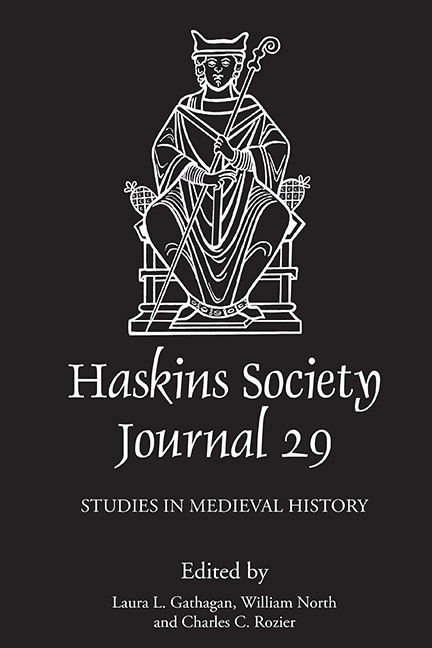Book contents
- Frontmatter
- Contents
- List of Figures and Tables
- Editors’ Note
- Abbreviations
- 1 The Longue Durée of a Symbolic System: Mounted Warriors and Horses in the Chronicon Salernitanum
- 2 Revolution(s) of Writing: Northern France, Tenth–Fourteenth Centuries
- 3 Slave or Free: The Aehtemann in Anglo-Saxon Rural Society
- 4 Norman Ducal Property in the Tenth and Eleventh Centuries: A Spatial and Chronological Analysis
- 5 The Codex Wintoniensis in its Twelfth-Century Context
- 6 The Carmen Ceccanense: A Neglected Source for the End of the Norman Kingdom of Sicily, Introduction – Edition – Translation
- 7 Succession and Interregnum in the English Polity: The Case of 1141
- 8 Crusading Participation in Normandy and its Borderlands: The Evidence from the Old French Traditions of the First Crusade
- 9 The Domesday Controversy: A Review and a New Interpretation
8 - Crusading Participation in Normandy and its Borderlands: The Evidence from the Old French Traditions of the First Crusade
Published online by Cambridge University Press: 15 October 2019
- Frontmatter
- Contents
- List of Figures and Tables
- Editors’ Note
- Abbreviations
- 1 The Longue Durée of a Symbolic System: Mounted Warriors and Horses in the Chronicon Salernitanum
- 2 Revolution(s) of Writing: Northern France, Tenth–Fourteenth Centuries
- 3 Slave or Free: The Aehtemann in Anglo-Saxon Rural Society
- 4 Norman Ducal Property in the Tenth and Eleventh Centuries: A Spatial and Chronological Analysis
- 5 The Codex Wintoniensis in its Twelfth-Century Context
- 6 The Carmen Ceccanense: A Neglected Source for the End of the Norman Kingdom of Sicily, Introduction – Edition – Translation
- 7 Succession and Interregnum in the English Polity: The Case of 1141
- 8 Crusading Participation in Normandy and its Borderlands: The Evidence from the Old French Traditions of the First Crusade
- 9 The Domesday Controversy: A Review and a New Interpretation
Summary
When Robert ‘Curthose’, duke of Normandy, set off on crusade in the autumn of 1096, he was evidently considered one of the major leaders of the expedition. Of the sixteen or so Latin texts which give a full history of the crusade, not one denies him a rank among the foremost figures on the road to Jerusalem, and his role only grew in subsequent refinements of crusade narrative. Although the contemporary sources make no mention of it, Robert's supposed heroic defeat in single combat of the leader of the enemy forces at Antioch, Kerbogha, made its way into the accounts of Chanson d'Antioche, William of Malmesbury, Geoffrey Gaimar, and Wace. It is his crusading military activity, above that of other participants, which was commemorated in the crusading windows of Saint-Denis in the later 1140s. Yet scholars of Normandy, the Anglo-Norman realms, and the three sons of the Conqueror have largely viewed Robert's crusading participation as firmly removed from his activities in Normandy. Previously, historians have argued that Robert sought to run away from his responsibilities, and the difficult situation he found himself in with regard to his brothers in 1095; the crusade was a convenient excuse, and Curthose threw away his domination over the duchy in order to escape. Yet more recent scholarship has shown that Robert was actually in a strong position immediately before the First Crusade, had held off encroachments from his brothers multiple times, and retained his duchy. In part, this separation of Curthose's crusade activity and his activities as duke stems from the medieval sources themselves: Robert's commendable crusading behaviour was, even at the time, seen as diametrically opposed to his negligent and flawed ducal rule. Yet I will argue here that the way Robert set about participating in the crusade was deeply rooted in the regional politics of the time. By supplementing the evidence of the Latin texts with two Anglo-Norman, barely studied, vernacular histories of the First Crusade dated to c. 1175–1250, this article argues that analysis of Curthose's retinue on the crusade provides a new understanding of the priorities which underlay crusade recruitment. It also suggests that Curthose selected his companions with an eye to maintaining a status quo in Normandy and its borderlands, whereby he could easily regain control on his return.
- Type
- Chapter
- Information
- The Haskins Society Journal 292017. Studies in Medieval History, pp. 201 - 224Publisher: Boydell & BrewerPrint publication year: 2018

